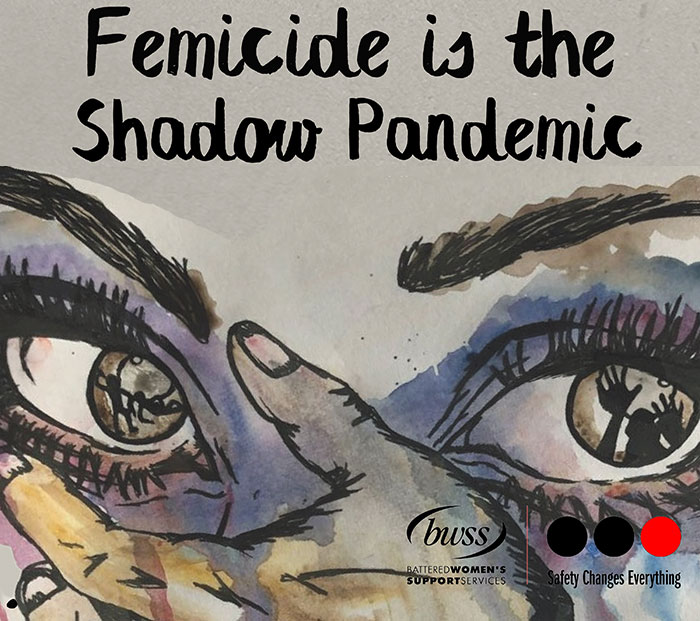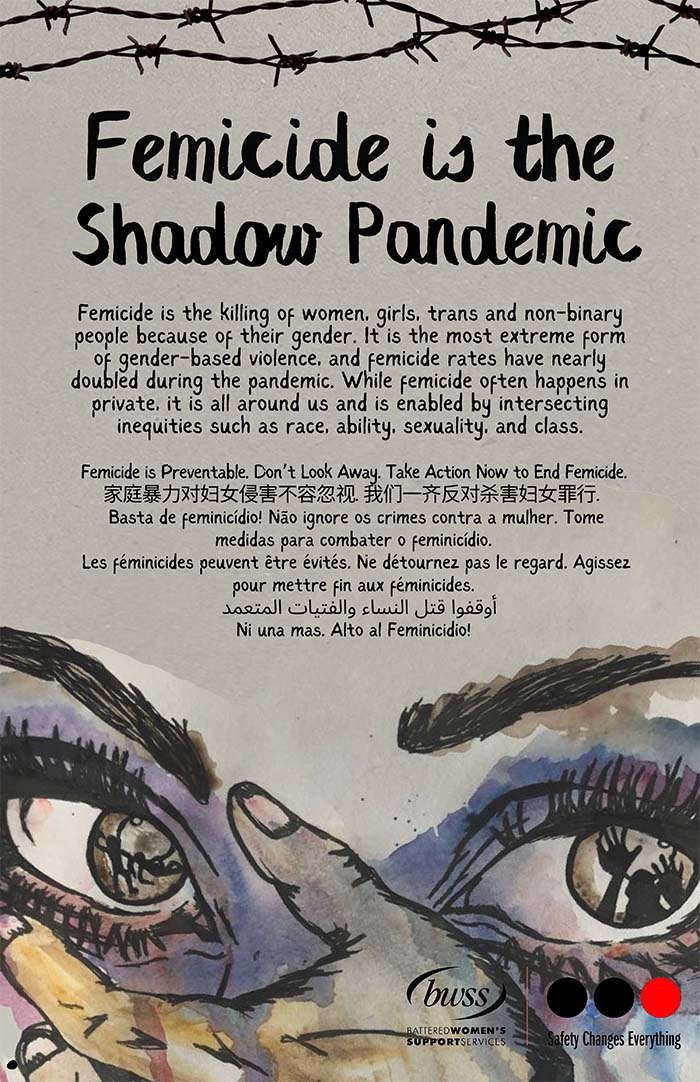Femicide is the Shadow Pandemic
Despite our efforts to bring a visible and a focus to femicide in British Columbia and Canada, our political leaders have ignored femicide as an everyday reality for women, girls, femmes, trans and non-binary people. As shown by the most recent Canadian Femicide Observatory for Justice and Accountability statistics, in 2020, an average of one woman or girl was killed every 2.5 days in Canada, and, in 2022, there has been an average of 1 femicide every 1.5 days in Canada.
This is an alarming increase since the pandemic. University of Guelph gender-based violence expert Dr. Myrna Dawson explains, “The numbers are showing increases over the three years – pre-COVID, beginning of COVID and as COVID continues – and in that context, it is something that we should be concerned about.”
Femicide is the killing of women, girls, trans and non-binary people explicitly motivated by and because of their gender.
Femicide is the most extreme form of violence on a continuum of gender-based violence and discrimination. Globally, according to data by the United Nations, 81,000 women and girls were killed in 2020 by an intimate partner or a family member, which equals a staggering 128 women killed per day around the world. We believe that even one femicide is too many!
In 2015, the United Nations Special Rapporteur on Violence Against Women, Its Causes and Consequences called on all countries to establish a femicide observatory to document gender-related killings which would collect, analyze, and review data on femicides with the aim of prevention.
Since then, in Canada, the independent Canadian Femicide Observatory for Justice and Accountability collects and analyses data on femicides in Canada and classifies femicide under two broad terms.
The first term is intimate femicide, also referred to as intimate partner femicide, which captures the killing of women, girls, femmes, trans and non-binary people by current or former partners.
The second term is non-intimate femicide, which involves the killing of women, girls, femmes, trans and non-binary people by someone with whom they did not share an intimate partner relationship, such as familial femicide, ‘know perpetrator’ femicide, and stranger femicide.
Cis men are the primary perpetrators of femicide and most femicides are committed by current or former male partners within relationships where there was a history of intimate partner violence.
The most recent information in Canada demonstrates that in 2020, 90 percent of perpetrators were male, and 41 percent of femicides where relationship status was known involved a current or former intimate partner. The study also found at least one in five women whose killers were identified were Indigenous women and girls.
While the act of femicide often happens in private, it is all around us and is enabled by intersecting inequities. Indigenous, Black, immigrant and refugee, racialized, and low-income women, young girls, and gender diverse people face compounding violence.
Femicide is perpetuated and maintained through broader patriarchal systems of oppression and ongoing forms of inequality.
At Battered Women’s Support Services, we work from a decolonial, intersectional, feminist perspective to eliminate gender-based violence and promote gender equity.
Since our very founding, we have recognized that gender-based violence, including femicide, does not only take place between two individuals in isolation but, rather, in a social context and a world view that systemically reinforces the power of some people to oppress others.
In Canada, for example, we know that Indigenous women are twelve times more likely to be murdered or missing than any other woman in Canada, and sixteen times more likely to be murdered or missing than white women in Canada.
According to Statistics Canada, between 2001 and 2015, homicide rates for Indigenous women were almost six times higher than for non-Indigenous women, and Indigenous women accounted for a staggering 24 percent of all female homicide victims in 2015.
While Indigenous survivors are victim-blamed for these horrifying forms and rates of violence they suffer, colonial patriarchy is the highest risk factor in Indigenous women’s lives.
We echo Cindy Holmes and Sara Hunt, who explain, “In our anti-violence and community-building work over the years, we have noticed that as the issue of violence against Indigenous people has been taken up in public discourse, violence within Indigenous families as been increasingly targeted as being to blame. Rather than making visible intersections of ongoing state neglect, racism, sexism, homophobia, and other expressions of colonialism in contributing to overwhelming realities of physical and sexual violence, public discourse naturalizes violence within Indigenous families and blames Indigenous people. These discourses rely on and reproduce gendered colonial stereotypes about Indigenous people, especially Indigenous women.”
“Reclaiming Power and Place: The Final Report of the National Inquiry into Missing and Murdered Indigenous Women and Girls” makes clear that violence against First Nations, Inuit, and Métis women, girls, two spirit, and gender diverse people in Canada stems from targeted colonial gendered violence.
As the Final Report states, “Canada is a settler colonial country. European nations, followed by the new government of ‘Canada,’ imposed its own laws, institutions, and cultures on Indigenous Peoples while occupying their lands.
Racist colonial attitudes justified Canada’s policies of assimilation, which sought to eliminate First Nations, Inuit, and Métis Peoples as distinct Peoples and communities. Colonial violence, as well as racism, sexism, homophobia, and transphobia against Indigenous women, girls, and 2SLGBTQQIA people, has become embedded in everyday life – whether this is through interpersonal forms of violence, through institutions like the health care system and the justice system, or in the laws, policies and structures of Canadian society.
The result has been that many Indigenous people have grown up normalized to violence, while Canadian society shows an appalling apathy to addressing the issue. The National Inquiry into Missing and Murdered Indigenous Women and Girls finds that this amounts to genocide.”
So, at BWSS, we stay on the frontline.
Our crisis line continues 24/7/365 receiving an average of 50 calls daily and our crisis line volunteers, support workers, legal advocates, and counsellors tirelessly respond to tens of thousands of requests for service annually.
We will also be launching our first report as part of our multi-year Colour of Violence project examining the intersections of race and gender for Indigenous, Black, newcomer immigrant/refugee, and racialized women and gender diverse people experiencing gender-based violence in British Columbia.
And this week, we will be on the streets of the Lower Mainland with our multilingual “Femicide is the Shadow Pandemic” posters raising awareness about the gruesome reality of femicide all around us.
We know that safety changes everything, and we are committed to ending femicide and all forms of gender-based violence.






